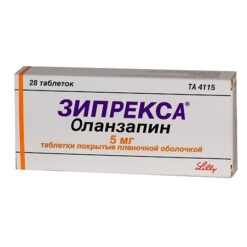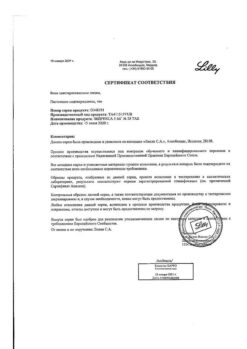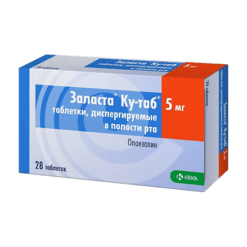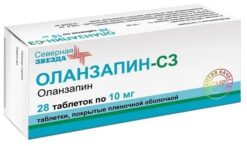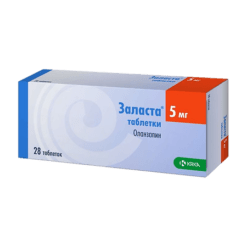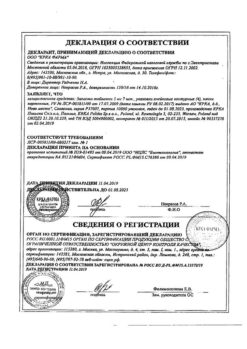No products in the cart.
Olanzapine, 5 mg 28 pcs
€10.75 €8.96
Out of stock
(E-mail when Stock is available)
Description Pharmacotherapeutic group:
Antipsychotic (neuroleptic)
ATX: Pharmacodynamics: Pharmacokinetics:
Absorption. Olanzapine has high absorption independent of food intake. Dispersible olanzapine tablets are bioequivalent to coated olanzapine tablets and have a similar rate and degree of absorption. They can be used in place of the coated tablets with the same amount and frequency. The time required to reach the maximum plasma concentration of the drug (TCmax) after oral administration is 5-8 hours. Studies with different doses ranging from 1 mg to 20 mg have shown that plasma concentrations of olanzapine vary linearly and in proportion to the dose.
Antipsychotic (neuroleptic)
N.05.A.H.03 Olanzapine
Olanzapine is an antipsychotic (neuroleptic) with a broad pharmacological spectrum of effects on a number of receptor systems. The affinity of olanzapine for serotonin 5-NT2A/2C, 5NT3, 5NT6, dopamine D1, D2, D3, D4, D5, muscarinic M1-5, adrenergic α1 and histamine H1 receptors has been established. Olanzapine was found to be antagonistic to serotonin, dopamine and cholinergic receptors. Moreover, olanzapine has a more pronounced affinity and activity towards serotonin 5NT2 receptors compared to dopamine D2 receptors. Olanzapine selectively reduces excitability of mesolimbic (A10) dopaminergic neurons, while having little effect on striatal (A9) nerve pathways involved in the regulation of motor function. Olanzapine reduces the conditioned protective reflex (a test characterizing antipsychotic activity) at doses lower than those that cause catalepsy (a disorder reflecting adverse effects on motor function). Olanzapine enhances the antianxiety effect of the “anxiolytic” test.
According to clinical studies using positron emission tomography on healthy volunteers, a single oral dose (10 mg) of olanzapine had a higher occupation of 5-NT2A receptors than dopamine D2 receptors. A study using single-photon emission computed tomography in patients with schizophrenia found that patients responding to olanzapine therapy had lower occupation of striatal D2 receptors than other patients responding to therapy with antipsychotics and other neuroleptics.
Olanzapine provides a statistically significant reduction in both productive (delirium, hallucinations, etc.) and negative symptoms.
Absorption. Olanzapine has high absorption independent of food intake. Dispersible olanzapine tablets are bioequivalent to coated olanzapine tablets and have a similar rate and degree of absorption. They can be used in place of the coated tablets with the same amount and frequency. The time required to reach the maximum plasma concentration of the drug (TCmax) after oral administration is 5-8 hours. Studies with different doses ranging from 1 mg to 20 mg have shown that plasma concentrations of olanzapine vary linearly and in proportion to the dose.
Distribution. Binding to serum proteins is 93% in the concentration range from 7 to 1000 ng/ml. Olanzapine binds primarily to albumin and α1-glycoprotein. It penetrates the histohematic barriers, including the blood-brain barrier (BBB).
Metabolism. Olanzapine is metabolized in the liver by conjugation and oxidation processes. The main circulating metabolite is l0-N-glucuronide, which theoretically does not cross the blood-brain barrier. Cytochrome P450 isoenzymes CYP1A2 and CYP2D6 are involved in the formation of N-desmethyl- and 2- hydroxymethylmetabolites of olanzapine. Both metabolites in animal studies had significantly less pronounced in vivo pharmacological activity than olanzapine. The main pharmacological activity of the drug is due to the parent substance olanzapine, which has the ability to penetrate through the histohematic barriers, including the blood-brain barrier. The activity of CYP2D6 cytochrome P450 isoenzyme does not affect the metabolism of olanzapine.
Elimination. In healthy volunteers after oral administration, the mean half-life was 33 hours (21-54 hours for 5-95%) and the mean clearance of olanzapine from plasma was 26 L/h (12-47 L/h for 5-95%). The half-life (T1/2) and plasma clearance are affected by smoking, gender, and age of the patient. Plasma clearance in women is lower than in men. It is excreted mainly by the kidneys (about 60%) as metabolites.
Pharmacokinetic parameters of olanzapine vary depending on smoking, sex and age (see table):
Patient characteristics | Half-life (hours) | Plasma clearance (l/h) | |
Non-smokers | 38.6 /p> | 18.6 | |
Smokers | 30.4 | 27.7 | |
Women | 36.7 | 18.9 | |
Men | 32.3 | 27.3 | |
Age 65 and older | 51.8 | 17.5 | |
Younger than 65 | 33.8 /p> | 18.2 |
However, the extent to which age, sex, or smoking affects olanzapine clearance and T1/2 is insignificant compared to the individual variability in pharmacokinetics among individuals.
Pharmacokinetics in Special Patient Groups
Renal Impairment
In patients with severe renal impairment, no significant differences were found between the mean T1/2 and plasma clearance of olanzapine compared to those with normal renal function
People with severe renal impairment had no significant differences between the mean T1/2 and plasma clearance of olanzapine
People with normal renal function/p>
Hepatic impairment
In patients with hepatic impairment and smokers, clearance of olanzapine is lower than in nonsmokers without hepatic impairment.
In a study involving persons of European, Japanese and Chinese descent, no differences in olanzapine pharmacokinetics related to race were found.
.
Indications
Indications
Schizophrenia. Olanzapine is indicated for the treatment of exacerbations, maintenance and long-term anti-relapse therapy of patients with schizophrenia and other psychotic disorders with severe productive (delusions, hallucinations, automatisms, etc.) and/or negative (emotional flatness, decreased social activity, impoverished speech) symptoms, as well as concomitant affective disorders.
Bipolar affective disorder. Olanzapine, alone or in combination with lithium or valproic acid, is indicated for the treatment of acute manic or mixed episodes in bipolar affective disorder with or without psychotic features and with or without rapid cycling. Olanzapine is indicated for the prevention of relapse of mania in patients with bipolar disorder in whom olanzapine has been effective in treating the manic phase.
In combination with fluoxetine, olanzapine is indicated for the treatment of depressive conditions associated with bipolar disorder (and for the treatment of treatment-resistant depression in adults).
Pharmacological effect
Pharmacological effect
Pharmacotherapeutic group:
Antipsychotic (neuroleptic)
ATX:
N.05.A.H.03 Olanzapine
Pharmacodynamics:
Olanzapine is an antipsychotic drug (neuroleptic) with a wide pharmacological spectrum of effects on a number of receptor systems. The affinity of olanzapine for serotonin 5-HT2A/2C, 5HT3, 5HT6, dopamine D1, D2, D3, D4, D5, muscarinic M1-5, adrenergic α1 and histamine H1 receptors has been established. Olanzapine was found to have antagonism at serotonin, dopamine and cholinergic receptors. At the same time, olanzapine has a more pronounced affinity and activity for serotonin 5HT2 receptors compared to dopamine D2 receptors. Olanzapine selectively reduces the excitability of mesolimbic (A10) dopaminergic neurons, and at the same time has a slight effect on striatal (A9) nerve pathways involved in the regulation of motor functions. Olanzapine reduces the conditioned defense response (a test that characterizes antipsychotic activity) at doses lower than doses that cause catalepsy (a disorder reflecting side effects on motor function). Olanzapine enhances the anti-anxiety effect during the “anxiolytic” test.
In clinical studies using positron emission tomography in healthy volunteers, when administered as a single oral dose (10 mg), olanzapine had a higher occupancy of 5-HT2A receptors than dopamine D2 receptors. A study using single-wave emission computed tomography in patients with schizophrenia found that patients responding to olanzapine had less striatal D2 receptor occupancy than other patients responding to antipsychotics and other antipsychotics.
Olanzapine provides a statistically significant reduction of both productive (delusions, hallucinations, etc.) and negative symptoms.
Pharmacokinetics:
Absorption. Olanzapine has a high absorption rate independent of food intake. Olanzapine dispersible tablets are bioequivalent to olanzapine film-coated tablets and have a similar rate and extent of absorption. Can be used instead of film-coated tablets, with the same amount and frequency. The time required to achieve the maximum concentration of the drug in the blood plasma (TCmax) after oral administration is 5-8 hours. In studies with different doses ranging from 1 mg to 20 mg, olanzapine plasma concentrations have been shown to change linearly and proportionally to the dose.
Distribution. Connection with serum proteins – 93% in the concentration range from 7 to 1000 ng/ml. Olanzapine binds primarily to albumin and α1-glycoprotein. Penetrates through histohematic barriers, incl. blood-brain barrier (BBB).
Metabolism. Olanzapine is metabolized in the liver as a result of conjugation and oxidation processes. The main circulating metabolite is l0-N-glucuronide, which theoretically does not cross the blood-brain barrier. Cytochrome P450 isoenzymes CYP1A2 and CYP2D6 are involved in the formation of N-desmethyl and 2-hydroxymethyl metabolites of olanzapine. Both metabolites had significantly less pharmacological activity in vivo than olanzapine in animal studies. The main pharmacological activity of the drug is due to the original substance, olanzapine, which has the ability to penetrate histohematic barriers, incl. blood-brain barrier. The activity of the cytochrome P450 isoenzyme CYP2D6 does not affect the level of metabolism of olanzapine.
Excretion. In healthy volunteers, after oral administration, the mean elimination half-life was 33 hours (21-54 hours for 5-95%), and the mean plasma clearance of olanzapine was 26 L/h (12-47 L/h for 5-95%). The half-life (T1/2) and plasma clearance are affected by smoking, gender and age of the patient. Plasma clearance in women is lower than in men. It is excreted mainly by the kidneys (about 60%) in the form of metabolites.
The pharmacokinetic parameters of olanzapine vary depending on smoking, gender and age (see table):
Patient characteristics
Half-life (hours)
Plasma clearance (l/h)
Non-smokers
38.6
18.6
Smoking
30.4
27.7
Women
36.7
18.9
Men
32.3
27.3
Ages 65 and older
51.8
17.5
Under 65 years old
33.8
18.2
However, the extent to which age, sex, or smoking influence olanzapine clearance and T1/2 is small compared with the interindividual variability in pharmacokinetics.
Pharmacokinetics in special groups of patients
Kidney failure
In patients with severely impaired renal function, no significant differences were found between the average values of T1/2 and olanzapine clearance in blood plasma, compared with individuals with normal renal function
Liver failure
In patients with hepatic impairment and smokers, the clearance of olanzapine is lower than in non-smokers, without impairment of liver function.
In a study involving subjects of European, Japanese and Chinese descent, there were no differences in the pharmacokinetics of olanzapine associated with race.
Special instructions
Special instructions
Hyperglycemia and diabetes mellitus
There is a higher prevalence of diabetes mellitus in patients with schizophrenia. There are very rare reports of the development of hyperglycemia and/or decompensation of diabetes mellitus, sometimes accompanied by the development of ketoacidosis or ketoacidotic coma, including reports of several fatal cases. In some cases, there was an increase in body weight preceding decompensation, which could become a predisposing factor. In patients with diabetes mellitus and risk factors for the development of this disease, regular clinical monitoring and monitoring of blood glucose concentrations is recommended.
Change in lipid concentration
During therapy with olanzapine, it is necessary to monitor plasma lipid concentrations in patients with dyslipidemia and in patients with risk factors for lipid metabolic disorders. Patients taking olanzapine therapy need to monitor their lipid profile. If lipid concentrations change, therapy adjustments are required.
Anticholinergic activity
In clinical studies, olanzapine therapy was rarely accompanied by adverse reactions due to blockade of M-cholinergic receptors. Because clinical experience with olanzapine in people with underlying medical conditions is limited, the drug should be used with caution in patients with clinically significant prostatic hyperplasia, paralytic ileus, angle-closure glaucoma, and similar conditions.
Use of olanzapine in patients with Parkinson’s disease
Olanzapine is not recommended for the treatment of psychosis caused by dopaminomimetics in Parkinson’s disease. Symptoms of parkinsonism and hallucinations increase. However, olanzapine was not superior to placebo in treating psychosis.
Dopaminergic antagonism
In vitro, olanzapine exhibits dopamine receptor antagonism and, like other antipsychotics (neuroleptics), can theoretically inhibit the action of levodopa and other dopamine receptor agonists.
Experience with olanzapine in elderly patients with dementia-related psychosis. The effectiveness of olanzapine in elderly patients with dementia-related psychosis has not been established. In placebo-controlled clinical studies (lasting 6-12 weeks) in elderly patients (mean age 78 years) suffering from psychosis and behavioral disturbances due to dementia, there was an increase in deaths in patients treated with olanzapine compared with placebo (3.5% versus 1.5%, respectively). The increase in mortality was independent of the olanzapine dose or duration of therapy. Risk factors predisposing to increased mortality include: age over 75 years, dysphagia, sedation, malnutrition and dehydration, lung diseases (for example, pneumonia, including aspiration), concomitant use of benzodiazepines.
Cerebrovascular adverse events including stroke in elderly patients with dementia
Cerebrovascular adverse events (stroke, transient ischemic attack), including deaths, were observed in studies of olanzapine in elderly patients with psychosis associated with dementia. In placebo-controlled studies, there was a higher incidence of cerebrovascular adverse events in patients in the olanzapine group compared with the placebo group (1.3% versus 0.4%, respectively). All patients had previous risk factors for cerebrovascular adverse events (smoking, hypertension, previous cerebrovascular adverse event or transient ischemic attack), as well as concomitant diseases with medications temporally associated with cerebrovascular adverse events.
Postural hypotension
Postural hypotension was not frequently observed in elderly patients during clinical trials of olanzapine. As with other antipsychotic drugs, periodic monitoring of blood pressure is recommended in patients over 65 years of age.
QT interval
In clinical trials, clinically significant prolongation of the QT interval (QT correction by Friederick’s formula [QTcF] ≥500 milliseconds in patients with baseline QTcF <500 msec) was uncommonly reported (0.1%-1%) in patients receiving olanzapine therapy, with no significant difference from placebo in associated cardiac events. However, as with other antipsychotic drugs, caution should be exercised when prescribing olanzapine concomitantly with drugs that can prolong the QT interval, especially in elderly patients, patients with long QT syndrome, congestive heart failure, cardiac hypertrophy, hypokalemia or hypomagnesemia. Electrocardiogram monitoring should be performed during olanzapine therapy.
Liver dysfunction
At the beginning of therapy, an asymptomatic increase in the activity of liver transaminases (ALT and AST) in the blood serum is often observed. Rare cases of hepatitis have been reported. In addition, there have been isolated reports of cholestatic and mixed liver damage. In patients with initially elevated serum AST and/or ALT levels, patients with liver failure and conditions that potentially limit liver function, and those taking hepatotoxic drugs, special caution should be exercised when prescribing olanzapine. If ALT and/or AST increase during drug therapy, medical monitoring of the patient and, possibly, a reduction in the dose of the drug are recommended. If hepatitis (including hepatocellular, cholestatic or mixed) is diagnosed, olanzapine should be discontinued.
Hematological changes
The drug should be used with caution in patients with leukopenia and/or neutropenia of any origin, myelosuppression of drug origin, as well as during radiation or chemotherapy, due to concomitant diseases, in patients with hypereosinophilic conditions or myeloproliferative diseases. Neutropenia was often observed with simultaneous use of olanzapine and valproic acid (see section “Side effects”).
Neuroleptic malignant syndrome (NMS)
NMS is a potentially life-threatening condition associated with treatment with antipsychotic drugs (neuroleptics), incl. olanzapine. Clinical manifestations of NMS: fever, muscle rigidity, impaired consciousness, autonomic disorders (unstable pulse or labile blood pressure, tachycardia, increased sweating, arrhythmias).
Additional symptoms of NMS: increased CPK, myoglobinuria (against the background of rhabdomyolysis) and acute renal failure. If symptoms of NMS develop, as well as an increase in body temperature for no apparent reason, it is necessary to discontinue all antipsychotics, incl. olanzapine.
Convulsive syndrome
Olanzapine should be used cautiously in patients with a history of seizures or risk factors that lower the seizure threshold. Seizures were rarely reported while taking olanzapine.
Tardive dyskinesia
In comparative studies, olanzapine therapy was significantly less likely to be accompanied by the incidence of tardive dyskinesia requiring drug correction than the use of typical and other atypical antipsychotics. The risk of developing tardive dyskinesia increases with increasing duration of therapy. If signs of tardive dyskinesia develop in a patient taking olanzapine, dose adjustment is recommended. Symptoms of dyskinesia may temporarily increase after discontinuation of the drug.
General activity in relation to the central nervous system
Caution should be exercised when using olanzapine and other centrally acting drugs simultaneously and avoid alcohol consumption.
Thromboembolism
Cases of venous thromboembolism have been reported very rarely (less than 0.01%) when taking olanzapine. A cause-and-effect relationship between olanzapine therapy and venous thrombosis has not been established. Because patients with schizophrenia often have acquired risk factors for venous thrombosis, all possible other factors (eg, immobilization) should be identified and preventive measures taken.
Sudden death
Clinical experience with all antipsychotics, including olanzapine, has shown a similar dose-dependent increase in the risk of sudden death due to acute heart failure. In a retrospective observational cohort study, the risk of suspected sudden cardiac death in patients treated with olanzapine was increased approximately twofold compared with patients not using antipsychotics. In the study, the risk for olanzapine was comparable to the risk for the atypical antipsychotics included in the pooled analysis.
Long-term drug therapy
With long-term therapy with olanzapine (up to 12 months), in order to prevent relapses in patients with bipolar disorders, there was an increase in body weight of >7% from the original (in 39.9% of patients). With longer therapy (more than 48 weeks), clinically significant changes were observed – increases in body weight, glucose concentration, total cholesterol/LDL/HDL or triglycerides. In adult patients who completed a 9-12 month course of treatment, an increase in mean blood glucose concentration was observed after approximately 6 months. Patients with risk factors for the development of concomitant diseases who are on long-term therapy with olanzapine need to be monitored by a specialist during the entire course of therapy.
Withdrawal syndrome
When olanzapine is stopped abruptly, very rarely (less than 0.01%) the following symptoms may develop: sweating, insomnia, tremor, anxiety, nausea or vomiting. When discontinuing the drug, a gradual dose reduction is recommended.
Use in children
Olanzapine is not recommended for use in children and adolescents under 18 years of age due to the lack of sufficient data on efficacy and safety. In short-term studies in patients 13 to 17 years of age, more significant increases in body weight and changes in lipid and prolactin concentrations were reported than in similar studies in adults (see section “Side effects”).
Impact on the ability to drive vehicles. Wed and fur.:
Patients taking olanzapine during treatment must be careful when driving vehicles and engaging in other potentially hazardous activities that require increased concentration and speed of psychomotor reactions, since olanzapine can cause drowsiness and dizziness.
Active ingredient
Active ingredient
Olanzapine
Composition
Composition
1 tablet contains:
active substance: olanzapine benzoate 6.95 mg, which corresponds to olanzapine 5.0 mg,
excipients: calcium hydrogen phosphate 141.05 mg, microcrystalline cellulose 40.00 mg, sodium carboxymethyl starch (type A) 10.00 mg, magnesium stearate 2.00 mg.
Pregnancy
Pregnancy
Due to limited experience with the drug in pregnant patients, olanzapine should be used during pregnancy only if the expected benefit to the mother justifies the potential risk to the fetus.
In studies on rats, it was found that olanzapine does not have carcinogenic or teratogenic effects and does not have mutagenic properties. However, olanzapine has been found to cause fetal growth retardation. Temporarily reduces fertility in mature individuals.
Women should be informed of the need to inform their doctor about an existing or planned pregnancy during olanzapine therapy. Newborns whose mothers took antipsychotic drugs in the third trimester of pregnancy are at risk of developing extrapyramidal disorders and/or withdrawal syndrome of varying severity and duration. There are isolated reports of tremor, hypertension, lethargy and somnolence in children born to mothers taking olanzapine in the third trimester of pregnancy. Such children should be under the supervision of a doctor after birth.
Studies have shown that olanzapine is excreted into breast milk. The mean dosage (mg/kg) the child received when maternal steady-state concentrations were reached was 1.8% of the maternal olanzapine dose (mg/kg). Breastfeeding is not recommended during olanzapine therapy.
Contraindications
Contraindications
– Hypersensitivity to olanzapine or other components of the drug;
– established risk of angle-closure glaucoma;
– angle-closure glaucoma,
– children under 18 years of age (efficacy and safety have not been established).
With caution:
Renal failure, liver failure, prostatic hyperplasia, paralytic ileus, epilepsy, history of convulsive syndrome, leukopenia and/or neutropenia of various origins, myelosuppression of various origins, incl. myeloproliferative diseases, hypereosinophilic syndrome, cardiovascular and cerebrovascular diseases or other conditions predisposing to hypotension, congenital prolongation of the QT interval on the electrocardiogram (ECG) (increased corrected QT interval (QTc) on the ECG), or in the presence of conditions that can potentially cause prolongation of the QT interval (eg, concomitant use of drugs that prolong the QT interval, congestive heart failure, hypokalemia, hypomagnesemia), old age, as well as simultaneous use of other centrally acting drugs; immobilization.
Side Effects
Side Effects
The table below summarizes the main side effects and their frequency that were reported during spontaneous reports, clinical trials and/or in the post-marketing period. In each group, adverse reactions are presented in descending order of importance.
Very common (≥10%)
Often (≥1 and <10%)
Uncommon (≥0.1 and <1%)
Frequency unknown
(frequency cannot be determined from available data)
Blood and lymphatic system disorders
Eosinophilia
Leukopenia
Neutropenia
Thrombocytopenia
Immune system disorders
Hypersensitivity
Metabolic and nutritional disorders
Weight gain1
Increased cholesterol concentration2,3
Increase in glucose concentration4
Increased triglyceride concentration2.5
Glucosuria
Increased appetite
Development or decompensation of diabetes mellitus, sometimes
accompanied by ketoacidosis and diabetic coma, including several deaths
Hypothermia
Nervous system disorders
Drowsiness
Dizziness
Akathisia6
Parkinsonism6
Dyskinesia6
Seizures (due to a history of seizures or risk factors for their development)
Amnesia
Dysarthria
Dystonia (including oculogyric crisis)
Neuroleptic malignant syndrome
Tardive dyskinesia Drug withdrawal syndrome7
Heart disorders
Bradycardia with or without collapse
Prolongation of the QTc interval on the ECG
Ventricular tachycardia/fibrillation
Sudden death
Vascular disorders
Arterial hypotension (including orthostatic)
Thromboembolism (including pulmonary embolism and deep vein thrombosis)
Digestive system disorders
Short-term, transient anticholinergic effects, incl. constipation and dry mouth
Bloating
Pancreatitis
Liver and biliary tract disorders
Asymptomatic, temporary increase in the level of “liver” transaminases (alanine aminotransferase (ALT), aspartate aminotransferase (AST)), especially at the beginning of treatment
Hepatitis (including hepatocellular, cholestatic or mixed liver disease)
Skin and subcutaneous tissue disorders
Rash
Photosensitivity reaction
Alopecia
Renal and urinary tract disorders
Urinary incontinence
Urinary retention
Disorders of the genital organs and breast
Erectile dysfunction
Decreased libido in men and women
Amenorrhea
Breast enlargement in women
Galactorrhea in women
Gynecomastia and breast enlargement in men
Musculoskeletal disorders
Arthralgia
General disorders
Asthenia
Fatigue
Peripheral edema
Hyperthermia
From the respiratory system
Nosebleeds
Pregnancy, prenatal and postnatal period
Withdrawal syndrome in newborns
Laboratory indicators
Increased plasma prolactin concentration8
Increased alkaline phosphatase activity
Increased creatine phosphokinase activity
Increased uric acid concentration
Increased concentration of total bilirubin
1All patient groups, regardless of body mass index, experienced a clinically significant increase in body weight.
An increase in body weight of 7% or more of the mean after short-term therapy (median duration of 47 days) was very common (22.2%), an increase of 15% or more was common (4.2%), and an increase of 25% or more was infrequent (0.8%). During long-term olanzapine therapy (>48 weeks), weight gain of ≥7%, ≥15%, and ≥25% from baseline was very common (64.4%, 31.7%, and 12.3%, respectively).
2 The mean increase in fasting lipid concentrations (total cholesterol, low-density lipoprotein (LDL), and triglycerides) was greatest in patients without baseline evidence of lipid abnormalities.
3An increase in cholesterol concentrations from normal fasting values (<5.17 mmol/L) to high values (≥6.2 mmol/L) was often observed. Changes in cholesterol concentrations from borderline fasting levels (≥5.17 - <6.2 mmol/L) to elevated levels (≥6.2 mmol/L) were very common.
4 An increase in glucose concentration from normal fasting values (<5.56 mmol/L) to elevated values (≥7 mmol/L) was often observed. Changes in glucose concentrations from borderline fasting values (≥5.56 - <7 mmol/l) to elevated (≥7 mmol/l) values were very frequent.
5 An increase in triglyceride concentrations from normal fasting values (<1.69 mmol/L) to elevated values (≥2.26 mmol/L) was often observed. Changes in triglyceride concentrations from borderline values (≥1.69 - <2.26 mmol/L) to elevated (≥2.26 mmol/L) were very common.
6 In typical studies, parkinsonism and dystonia were observed in patients treated with olanzapine, but were not statistically significantly different from the placebo group. Patients taking olanzapine were less likely to develop Parkinson’s disease, akathisia, and dystonia than patients taking titrated doses of haloperidol. Due to the lack of detailed information on the history of acute and tardive dyskinesias in patients, it is currently not possible to conclude that olanzapine is less likely to cause the development of tardive dyskinesias or other tardive extrapyramidal syndromes.
7Symptoms such as sweating, insomnia, tremor, anxiety, nausea and vomiting have been observed when olanzapine was abruptly discontinued.
8 In clinical studies of up to 12 weeks, plasma prolactin concentrations exceeded the upper limit of normal in approximately 30% of patients with normal baseline prolactin values. In most of these patients, the increase in prolactin concentrations was moderate and less than 2 times the upper limit of normal. There have also been cases where patients’ prolactin concentrations spontaneously returned to normal without discontinuing therapy.
Undesirable effects in special groups of patents
According to clinical studies, very common (≥ 10%) adverse effects during olanzapine therapy in elderly patients with psychosis associated with dementia include gait disturbances and falls. Pneumonia, lethargy, erythema, visual hallucinations, and urinary incontinence were common (<10% and ≥1%) cases.
In clinical studies in patients with drug-induced (dopamine agonist-induced) psychosis associated with Parkinson’s disease, increased parkinsonian symptoms were observed very often (≥ 10%) and at a higher frequency than in the placebo group. Hallucinations were also very common in this group of patients.
In patients with bipolar mania, during combination therapy with valproic acid, the incidence of neutropenia was (4.1%), a contributing factor being a high concentration of valproate in the blood plasma.
In patients with bipolar mania taking olanzapine in combination therapy with lithium or valproic acid, very common (≥10%) adverse effects were weight gain, dry mouth, increased appetite, and tremor. Speech disorder was also common (<10% and ≥1%).
Long-term therapy
With long-term olanzapine therapy (at least 48 weeks), the incidence of clinically significant adverse effects (weight gain, increased glucose concentrations, total cholesterol/LDL/HDL cholesterol or triglycerides) increases over time. In adult patients who completed a 9-12 month course of treatment, an increase in mean blood glucose concentration was observed after approximately 6 months.
Long-term olanzapine therapy (up to 12 months) to prevent relapse in patients with bipolar disorder was also associated with weight gain.
Olanzapine is not recommended for use in children.
The use of olanzapine in children and adolescents under 18 years of age is not recommended.
In a short-term efficacy study in patients 13–17 years of age (study included less than 200 adolescents), olanzapine was used in a dose range ranging from 2.5 to 20 mg/day. – the development of various adverse reactions has been registered. Long-term effects associated with these events have not been studied. With comparable olanzapine exposure, clinically significant weight gain (≥7%) was more common in adolescents than in adult patients.
The extent of change in fasting total cholesterol, LDL cholesterol, triglycerides, and prolactin concentrations was greater in adolescents than in similar studies in adult patients. Data on efficacy and safety are limited.
Interaction
Interaction
Potential drug interactions affecting the metabolism of olanzapine: Olanzapine is metabolized by the CYP1A2 isoenzyme, therefore inhibitors or inducers of cytochrome P450 isoenzymes that exhibit specific activity against the CYP1A2 isoenzyme may affect the pharmacokinetic parameters of olanzapine.
Inducers of the CYP1A2 isoenzyme: the clearance of olanzapine may be increased in patients who smoke or when taking carbamazepine simultaneously, which leads to a decrease in the concentration of olanzapine in the blood plasma. Clinical observation is recommended because some cases require increasing the dose of the drug.
Inhibitors of the CYP1A2 isoenzyme: fluvoxamine, a potent specific inhibitor of the CYP1A2 isoenzyme, significantly reduces the clearance of olanzapine. The average increase in the maximum concentration (Cmax) of olanzapine after taking fluvoxamine in non-smoking women was 54%, and in smoking men – 77%. The mean increase in the area under the concentration-time curve (AUC) of olanzapine in these patient categories was 52% and 108%, respectively. In patients taking fluvoxamine or any other CYP1A2 inhibitor (eg, ciprofloxacin), olanzapine therapy is recommended to begin with lower doses. A dose reduction of olanzapine may also be required if CYP1A2 isoenzyme inhibitors are added to therapy.
Drug interactions that do/do not affect the bioavailability of olanzapine: Activated charcoal reduces the oral absorption of olanzapine by 50-60% and should therefore be taken at least 2 hours before or after taking olanzapine. A single dose of magnesium or aluminum containing antacids or cimetidine does not affect the pharmacokinetics of olanzapine.
Fluoxetine (an inhibitor of CYP450 isoenzymes), when taken together (60 mg once or 60 mg daily for 8 days), causes an increase in the maximum concentration (Cmax) of olanzapine by an average of 16% and a decrease in olanzapine clearance by an average of 16%. The degree of influence of this factor is significantly lower than the severity of individual differences in these indicators, therefore it is usually not recommended to change the dose of olanzapine when used in combination with fluoxetine.
The potential for olanzapine to interfere with other medications
Olanzapine may reduce the effects of direct and indirect dopamine agonists.
In vitro, olanzapine does not inhibit the main CYP450 isoenzymes (for example, 1A2, 2D6, 2C9, 2C19, 3A4). In vivo, no inhibition of the metabolism of the following active substances was found: tricyclic antidepressants (CYP2D6 isoenzyme), warfarin (CYP2C9 isoenzyme), theophylline (CYP1A2 isoenzyme) and diazepam (CYP3A4 and 2C19 isoenzymes).
No interaction was detected when used simultaneously with lithium or biperiden. Therapeutic monitoring of the content of valproic acid in plasma showed that when administered simultaneously with olanzapine, no changes in doses of valproic acid are required (see section “Side effects”).
Potential drug interactions affecting the metabolism of olanzapine: Olanzapine is metabolized by the CYP1A2 isoenzyme, therefore inhibitors or inducers of cytochrome P450 isoenzymes that exhibit specific activity against the CYP1A2 isoenzyme may affect the pharmacokinetic parameters of olanzapine.
Inducers of the CYP1A2 isoenzyme: the clearance of olanzapine may be increased in patients who smoke or when taking carbamazepine simultaneously, which leads to a decrease in the concentration of olanzapine in the blood plasma. Clinical observation is recommended because some cases require increasing the dose of the drug.
Inhibitors of the CYP1A2 isoenzyme: fluvoxamine, a potent specific inhibitor of the CYP1A2 isoenzyme, significantly reduces the clearance of olanzapine. The average increase in the maximum concentration (Cmax) of olanzapine after taking fluvoxamine in non-smoking women was 54%, and in smoking men – 77%. The mean increase in the area under the concentration-time curve (AUC) of olanzapine in these patient categories was 52% and 108%, respectively. In patients taking fluvoxamine or any other CYP1A2 inhibitor (eg, ciprofloxacin), olanzapine therapy is recommended to begin with lower doses. A dose reduction of olanzapine may also be required if CYP1A2 inhibitors are added to therapy. Drug interactions affecting/not affecting the bioavailability of olanzapine. Activated charcoal reduces the oral absorption of olanzapine by 50-60% and should be taken at least 2 hours before or after olanzapine. A single dose of magnesium or aluminum containing antacids or cimetidine does not affect the pharmacokinetics of olanzapine.
Fluoxetine (an inhibitor of CYP450 isoenzymes), when taken together (60 mg once or 60 mg daily for 8 days), causes an increase in the maximum concentration (Cmax) of olanzapine by an average of 16% and a decrease in olanzapine clearance by an average of 16%. The degree of influence of this factor is significantly lower than the severity of individual differences in these indicators, therefore it is usually not recommended to change the dose of olanzapine when used in combination with fluoxetine.
The potential for olanzapine to interfere with other medicinal products Olanzapine may reduce the effects of direct and indirect dopamine agonists.
In vitro, olanzapine does not inhibit the main CYP450 isoenzymes (for example, 1A2, 2D6, 2C9, 2C19, 3A4). In vivo, no inhibition of the metabolism of the following active substances was found: tricyclic antidepressants (CYP2D6 isoenzyme), warfarin (CYP2C9 isoenzyme), theophylline (CYP1A2 isoenzyme) and diazepam (CYP3A4 and 2C19 isoenzymes).
No interaction was detected when used simultaneously with lithium or biperiden. Therapeutic monitoring of valproic acid levels in plasma showed that no changes in valproic acid doses are required when administered concomitantly with olanzapine (see section “Side Effects”).
Caution should be exercised when using other centrally acting drugs simultaneously. Although a single dose of alcohol (45 mg/70 kg) does not have a pharmacokinetic effect, taking alcohol with olanzapine may be accompanied by an increased inhibitory effect on the central nervous system.
Overdose
Overdose
Symptoms. Very common (>10%) with an overdose of olanzapine are: tachycardia, agitation/aggression, speech impairment, various extrapyramidal disorders and disturbances of consciousness of varying severity (from sedation to coma); in less than 2% of cases the following occur: delirium, convulsions, coma, neuroleptic malignant syndrome, respiratory depression, aspiration, increased or decreased blood pressure, cardiac arrhythmias; in very rare cases, cardiopulmonary failure. The minimum dose of olanzapine for an acute overdose with a fatal outcome is 450 mg; the maximum dose for an overdose with a favorable outcome (survival) is 2 g.
Treatment. There is no specific antidote for olanzapine. It is not recommended to induce vomiting. Symptomatic treatment in accordance with the clinical condition and monitoring of vital functions of the body, including treatment of arterial hypotension, arrhythmias, circulatory disorders and maintenance of respiratory function, gastric lavage, intake of activated charcoal (reduces the bioavailability of olanzapine to 50-60%). Epinephrine, dopamine and other sympathomimetics, which are beta-adrenergic agonists, should not be used, as these drugs may worsen arterial hypotension. The patient should be under continuous medical supervision until complete recovery.
Storage conditions
Storage conditions
In a place protected from light at a temperature not exceeding 25 ° C.
Keep out of the reach of children.
Shelf life
Shelf life
3 years
Do not use after expiration date.
Manufacturer
Manufacturer
Ozon, Russia
Additional information
| Shelf life | 3 years Do not use after the expiration date. |
|---|---|
| Conditions of storage | In the dark place at a temperature not exceeding 25 °С. Store out of the reach of children. |
| Manufacturer | Ozon, Russia |
| Medication form | pills |
| Brand | Ozon |
Other forms…
Related products
Buy Olanzapine, 5 mg 28 pcs with delivery to USA, UK, Europe and over 120 other countries.


